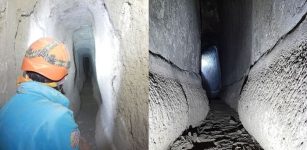Advanced Technology Of The Ancients: Artificial Platforms Of Mighty Nan Madol
A. Sutherland - AncientPages.com - Two very remarkable islands - Kosrae and Pohnpei ("upon a stone altar") - can be found in the Caroline Islands, a widely scattered archipelago located in the western Pacific Ocean, to the north of New Guinea and more than 1,500 miles to the east of the Philippines.
The ruins of Nan Madol on Pohnpei Island. Image credit: NOAA - Public Domain
These two places are full of mysteries, particularly because of bizarre remains of ancient architecture, in the form of very old megalithic cities, of which origin no one is able to guess."
Those, who do not invalidate the myths and legends of the ancients, can ponder over some interesting legends and myths. One of them says that "magic powers" were used to transport the logs from a far-away location, by making them fly and yet another legend supports the latter, saying about a mighty "magician" who made the logs fly towards Nan Madol, where the city was constructed and a firebreathing dragon became its symbol.
Who was interested in building two of the Pacific's largest basalt cities?
How were the huge, very heavy basalt columns and logs quarried and transported? In what manner were the walls constructed so high?
Who built the megalithic complexes, when and why were they built on both islands, at all?
Legends say that giants once lived on Ponape and archaeologists have discovered human bones belonging to people much taller than the natives of the region. They had at their disposal the physical means to carry the heavy basalt logs and built walls as high as 50 feet and as thick as 17 feet.
The inhabitants of both islands have absolutely no idea about their origin because the ruins were already in place at the time of the arrival of the early settlers.
The ruins of Nan Madol in Pohnpei. Image credit: CT Snow - CC BY 2.0
The ruins on the island of Kosrae are known among the white people as the "city of kings, and among the natives as "Insaru". They were built of huge hexagonal stone blocks and many of them have a mass between 30 to 60 tons, and according to a professional opinion of civil engineers and architects, the hexagonal blocks must be cut with mathematical exactness in all their dimensions.
A survey conducted on the Lelu Stone Ruins of Kosrae since 1978, showed west of the hill was artificial — a 0.6-1.0 meter deep fill of coral and basalt stone, with man-made extensions of the island, which bravely resist tropical cyclones of the Pacific Ocean.
Today, the ruined city on Kosrae has been reclaimed by the jungle and it is not visited so frequently as neighboring Nan Madol on Ponape. Nan Madol is a strange place, built into the ocean (!) which means that it is not located on the dry land of Ponape Island.
The origin of the basalt building stones used to construct Nan Madol is old. Basalt was most probably transported from only one far-away location on the opposite side of the island to the coral reef.
As no traces of prehistoric machines were found., archaeologists speculated that the builders used rafts. However, all attempts to use rafts to transport heavy construction material - failed because heavy, iron rich hard rock immediately sank due to its weight.
"Immense columns of prismatic basalt rock, quarried from various locations around the island, formed high-walled rectangular enclosures for the coral rubble used as fill for the islets' floor. Built over an extended period of time, Nan Madol eventually came to consist of ninety-two artificial islets that covered an area of 200 acres.. The most spectacular of the complex's structures reached a height of 25 feet..." (D.L. Hanlon)
It is estimated that at least 250 million tons of basalt logs are needed to construct a city, the size of Nan Madol and relatively long distance that separates Ponape island from the larger landmasses makes the history of the ruins fascinating.
At the peak of the last glacial maximum, Ponape Island was situated over a thousand kilometers to the north from the eastern edge of the Peninsula and the chain of islands, which today, partly form the Solomon Archipelago.
But the truth is that nobody knows when the megalithic complex was built and this is one of the biggest mysteries of archaeology.
All that's left of the earlier prehistoric city was named by the natives as "Nan Madol" and means "spaces between". The name may refer to an extended system of channels but it can mean something completely different. According to some opinions, Nan Madol could have been some religious and ceremonial center, but... was it?
"No site in Oceania surpasses the dramatic beauty of ancient Nan Madol... situated on the coast of Pohnpei, the elite administrative and ceremonial center grew, flourished and declined during the centuries preceding Western contact..." (W. N. Morgan)
It is a magnificent complex of ninety-two artificial islets interconnected by a network of waterways and according to Dr. Ayres, Professor of Anthropology at the University of Oregon and a researcher at Nan Madol, with extensive experience in Pacific archaeology, "to withstand time and the sea, the artificial platforms were built in a staggeringly laborious process."
"Multiton basalt columns, formed by volcanic activity, were stacked horizontally, log-cabin style, to form outer walls..."
Written by – A. Sutherland - AncientPages.com Senior Staff Writer
Copyright © AncientPages.com All rights reserved. This material may not be published, broadcast, rewritten or redistributed in whole or part without the express written permission of AncientPages.com
Expand for referencesReferences:
Ehrlich P., Hadley M., Nan Madol: Spaces on the Reef of Heaven
Morgan, William N. Prehistoric Architecture in Micronesia
More From Ancient Pages
-
 Zoroaster’s Doomsday Prophecy About Comet Gochihr And Its Similarity With The Apocalypse Of John In The Book Of Revelation
Biblical Mysteries | Aug 17, 2017
Zoroaster’s Doomsday Prophecy About Comet Gochihr And Its Similarity With The Apocalypse Of John In The Book Of Revelation
Biblical Mysteries | Aug 17, 2017 -
 Ancient Roman Portable Toilets Studied By Scientists
Archaeology | Feb 11, 2022
Ancient Roman Portable Toilets Studied By Scientists
Archaeology | Feb 11, 2022 -
 Giant Ancient Roman Underground Structure Discovered Near Naples, Italy – Aqua Augusta Investigated
Archaeology | Feb 6, 2023
Giant Ancient Roman Underground Structure Discovered Near Naples, Italy – Aqua Augusta Investigated
Archaeology | Feb 6, 2023 -
 Prehistoric Spread Of Millet From East Asia To Central Europe – New Study
Archaeology | Jun 10, 2022
Prehistoric Spread Of Millet From East Asia To Central Europe – New Study
Archaeology | Jun 10, 2022 -
 Ancient Burial Of Woman Equipped With A Unique Gold Pectoral Ornament Discovered In Siberian ‘Valley Of The Kings’
Archaeology | Feb 15, 2022
Ancient Burial Of Woman Equipped With A Unique Gold Pectoral Ornament Discovered In Siberian ‘Valley Of The Kings’
Archaeology | Feb 15, 2022 -
 Marriage And Divorce In Ancient Egypt Were Different But Uncomplicated
Ancient History Facts | Dec 12, 2018
Marriage And Divorce In Ancient Egypt Were Different But Uncomplicated
Ancient History Facts | Dec 12, 2018 -
 Radar Discovery Of Unknown Space Beyond Tutankhamun’s Burial Chamber May Lead To Queen Nefertiti’s Tomb
Archaeology | Feb 21, 2020
Radar Discovery Of Unknown Space Beyond Tutankhamun’s Burial Chamber May Lead To Queen Nefertiti’s Tomb
Archaeology | Feb 21, 2020 -
 Mary Boleyn – King Henry VIII’s Other Woman And Sister Of Anne Boleyn
Featured Stories | Jul 24, 2018
Mary Boleyn – King Henry VIII’s Other Woman And Sister Of Anne Boleyn
Featured Stories | Jul 24, 2018 -
 Ancient Sound Of Stones – Acoustics At Stonehenge Tested By Scientists
Ancient Technology | Aug 29, 2020
Ancient Sound Of Stones – Acoustics At Stonehenge Tested By Scientists
Ancient Technology | Aug 29, 2020 -
 Undersea Scans Reveal Astonishing Ancient Submerged World Of The Adriatic Sea
Archaeology | May 11, 2024
Undersea Scans Reveal Astonishing Ancient Submerged World Of The Adriatic Sea
Archaeology | May 11, 2024 -
 Never-Before-Seen Roman-Era Wall Paintings Discovered In Ashkelon Revealed To The Public For The First Time
Archaeology | Aug 30, 2024
Never-Before-Seen Roman-Era Wall Paintings Discovered In Ashkelon Revealed To The Public For The First Time
Archaeology | Aug 30, 2024 -
 Mysterious Biblical Canaanites – What Ancient DNA Reveals About Their Fate
Archaeology | Jul 28, 2017
Mysterious Biblical Canaanites – What Ancient DNA Reveals About Their Fate
Archaeology | Jul 28, 2017 -
 Amazing ‘Sigiriya’- ‘Lion Rock’ Fortress In Sri Lanka With Frescoes, Mirror Wall And Miniature Gardens
Civilizations | Jan 4, 2019
Amazing ‘Sigiriya’- ‘Lion Rock’ Fortress In Sri Lanka With Frescoes, Mirror Wall And Miniature Gardens
Civilizations | Jan 4, 2019 -
 Two-Faced Great Roman God Janus – Symbol Of All Beginnings And Endings
Featured Stories | Apr 9, 2021
Two-Faced Great Roman God Janus – Symbol Of All Beginnings And Endings
Featured Stories | Apr 9, 2021 -
 On This Day In History: Teotihuacan’s Warlord Siyaj K’ak’ Conquers Tikal – On Jan 16, 378
News | Jan 16, 2017
On This Day In History: Teotihuacan’s Warlord Siyaj K’ak’ Conquers Tikal – On Jan 16, 378
News | Jan 16, 2017 -
 INAH Archaeologists Focus On Ancient Religious And Ceremonial Site Of Teteles Of Avila Castle, Puebla, Mexico
Archaeology | Nov 7, 2024
INAH Archaeologists Focus On Ancient Religious And Ceremonial Site Of Teteles Of Avila Castle, Puebla, Mexico
Archaeology | Nov 7, 2024 -
 Ancient Nanotechnology Knowledge Inspired A Modern 3D-Printable ‘Lycurgus Cup’
Ancient Technology | Mar 13, 2019
Ancient Nanotechnology Knowledge Inspired A Modern 3D-Printable ‘Lycurgus Cup’
Ancient Technology | Mar 13, 2019 -
 Thousands Magnificent Jade Artifacts Discovered In Han Dynasty Tombs – China’s Golden Age In New Light
Archaeology | Jul 23, 2020
Thousands Magnificent Jade Artifacts Discovered In Han Dynasty Tombs – China’s Golden Age In New Light
Archaeology | Jul 23, 2020 -
 Did An Ancient Supernova Force Humans To Walk Upright?
Human Beginnings | Oct 24, 2019
Did An Ancient Supernova Force Humans To Walk Upright?
Human Beginnings | Oct 24, 2019 -
 Roman Consuls Seized Power Through Intimidation, Bribery And Show Business
Ancient History Facts | Feb 24, 2021
Roman Consuls Seized Power Through Intimidation, Bribery And Show Business
Ancient History Facts | Feb 24, 2021


